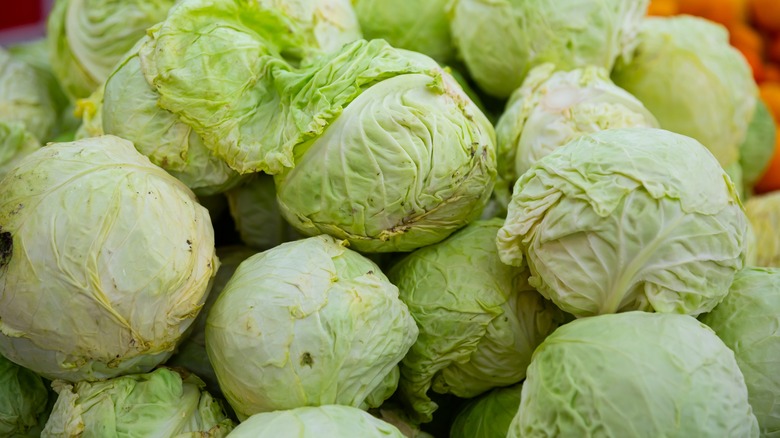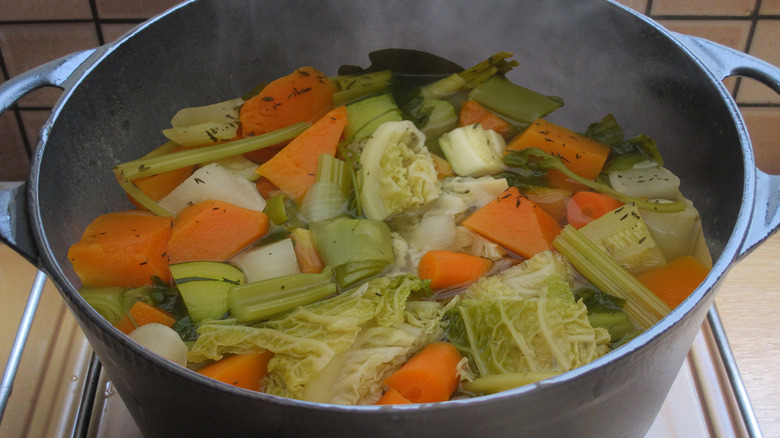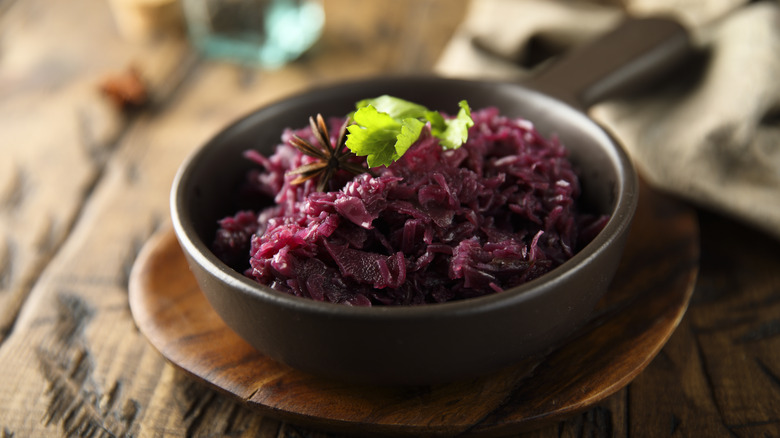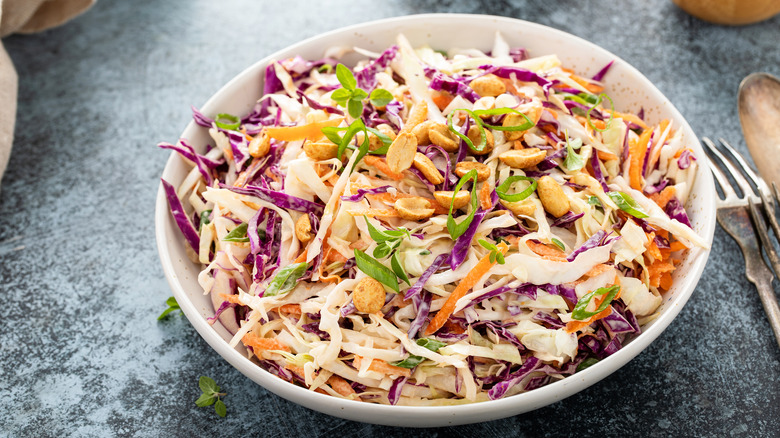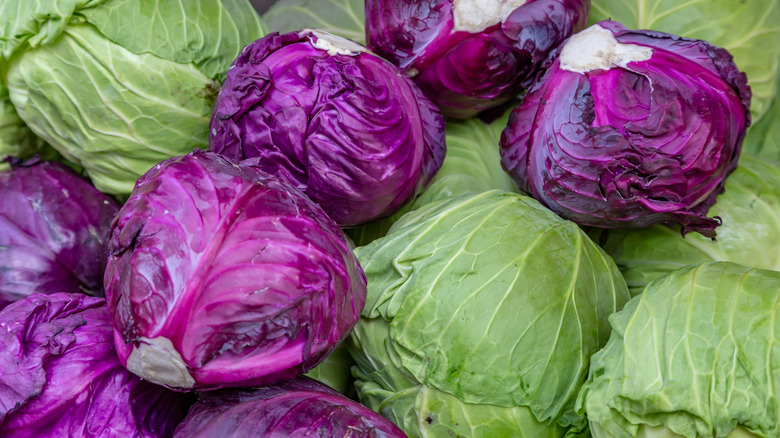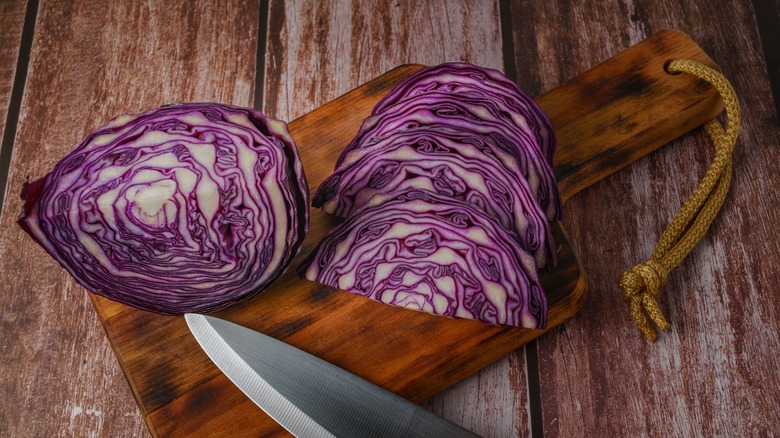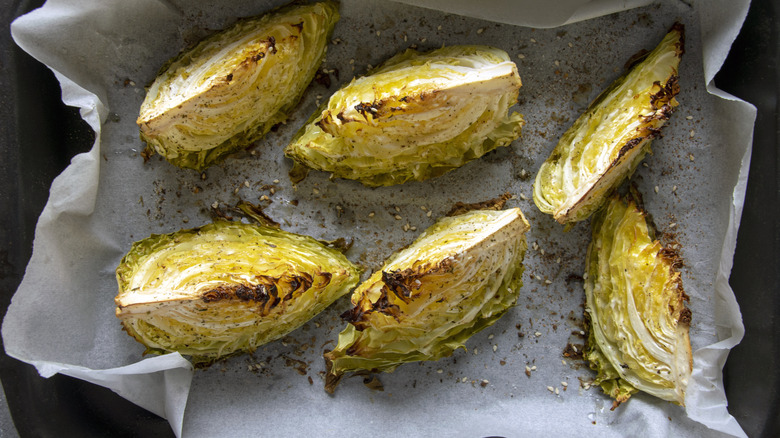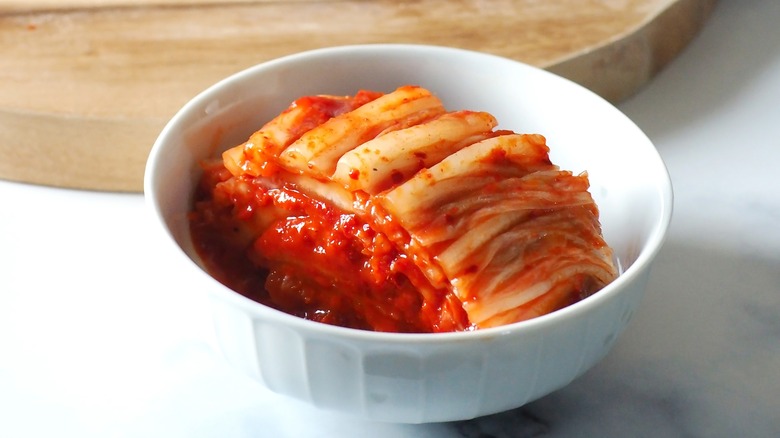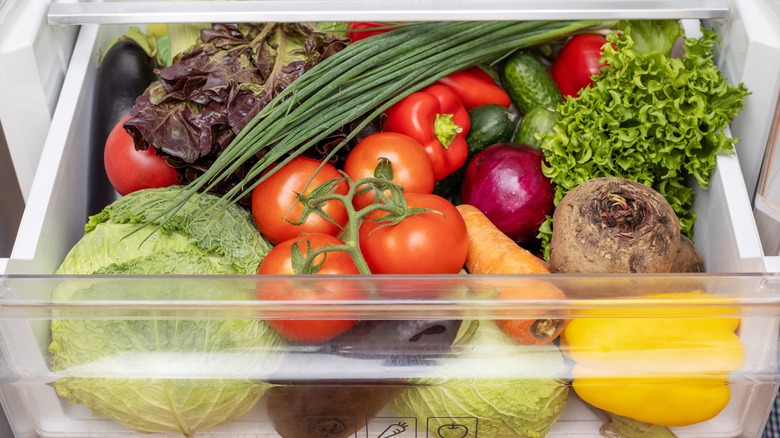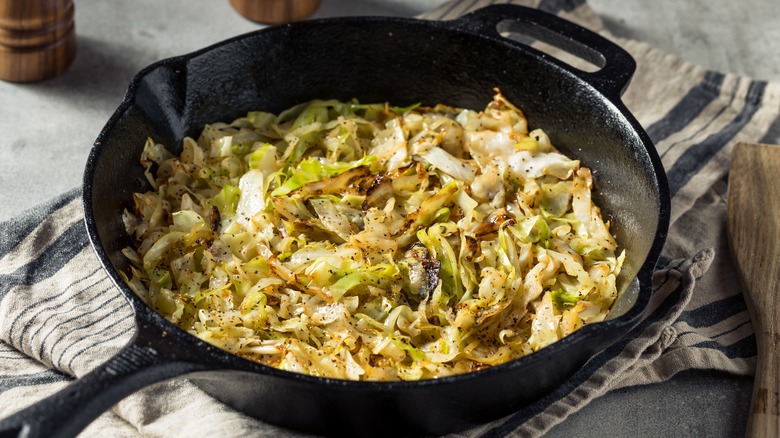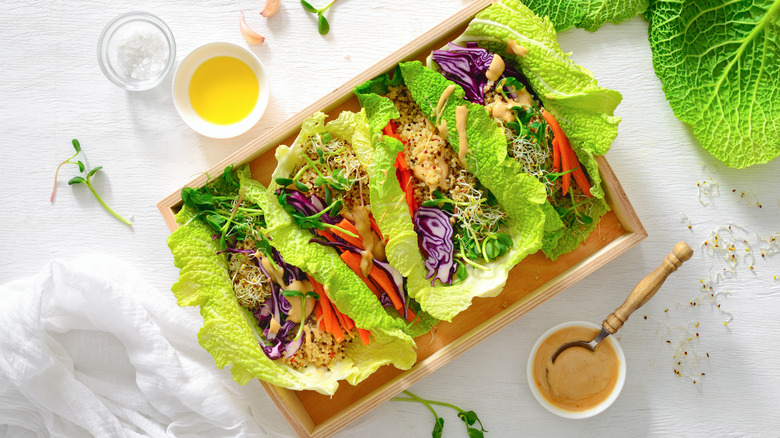Mistakes Everyone Makes When Cooking Cabbage
It's no secret that cabbage is good for you. Per Healthline, it's packed full of vitamins and minerals, including vitamin C, vitamin K, folate, calcium, and magnesium. But not everybody loves it. Perhaps you're sick of soggy cabbage that smells like old farts or you've just never had cabbage that you're actively excited about. Your problem might not be the fault of the cabbage but a fault in the way you're preparing it. There are a number of common mistakes that everyone makes when cooking and preparing cabbage that can leave this cruciferous vegetable less than delicious. Luckily, these mistakes are easy to rectify.
From overcooking green cabbage or undercooking red cabbage to assuming that you can only boil cabbage or sticking to just one variety of cabbage, there are so many pitfalls. But, once you know these mistakes, it's simple to avoid them. Don't let a few bad experiences with cabbage ruin it for you. Instead, embrace everything this delicious veggie has to offer and experiment with different ways to enjoy it. Once you know what not to do and what you should do instead, your whole relationship with cabbage will change. Prepare to become a cabbage convert and start singing its praises to anyone who will listen.
Cooking green cabbage too long
If you've ever boiled green cabbage and noticed that your kitchen started smelling more like a public bathroom than a place that prepares dinner, you've been cooking it for too long. Overcooked cabbage can release sulfur compounds, which can result in a strong, unpleasant odor. This can be especially noticeable when boiling or simmering cabbage for an extended period.
But, it's not just the bad smell you have to contend with. Overcooking cabbage causes it to become mushy and limp. It can also lose its vibrant green color. All this makes it less appealing both visually and texturally. Plus, overcooking can cause a significant loss of vitamins and minerals (via Sutter Health). These nutrients are sensitive to heat and can break down when exposed to prolonged high temperatures. What's more, prolonged cooking can alter the flavor of cabbage, making it taste more bitter or bland rather than retaining its natural sweetness and mildness.
To avoid these issues, it's best to cook green cabbage until it's tender but still retains some crispness and its vibrant color. Steaming, sautéing, stir-frying, or roasting are cooking methods that can help preserve the cabbage's texture, color, and nutritional value while enhancing its flavor. If you're using cabbage in dishes that require longer cooking times, such as soups or stews, consider adding it towards the end of the cooking process to prevent overcooking.
Not cooking red cabbage long enough
Unlike green cabbage, red cabbage can stand up to a much longer cooking time. In fact, most braised red cabbage recipes call for a long cooking period of around 1 to 2 hours. Of course, you don't have to cook red cabbage in this way, but if you've never experimented with a long cooking time, you've made a mistake. This longer cooking time gives it a soft, melt-in-the-mouth texture.
Braised red cabbage is a dish made by slowly cooking red cabbage with various flavorings and liquids until it becomes tender and flavorful. The braising process helps red cabbage develop rich, complex flavors. It has a sweet, tangy flavor with a hint of earthiness. The natural sweetness of the red cabbage is enhanced during braising, and the tanginess comes from the addition of acidic ingredients like vinegar or apples. Red cabbage braised over a long period becomes delectably tender but still retains some bite. Unlike overcooked cabbage, braised cabbage should not be mushy.
This dish is often cooked with a variety of aromatics and complementary ingredients. Common additions include onions, apples, red wine, balsamic vinegar, spices like cloves or cinnamon, and sometimes a touch of sugar or honey to enhance the sweetness. You can serve is served as a flavorful side dish to accompany various main courses. It's a popular dish in European cuisines, particularly in German, Scandinavian, and Central European cooking.
Not salting cabbage destined for slaw
Have you noticed your coleslaw or other slaws turning limp or watery? Well, there's a simple step to fix this — salting your cabbage. Salting cabbage before using it to make slaw improves the texture and flavor of the final dish. Cabbage contains a high amount of water, and salting helps draw out some of this moisture from the cabbage leaves. This step can prevent your slaw from becoming too watery or soggy once you add the dressing. Excess moisture can dilute the flavors and make the slaw less appealing. This process also helps improve the texture of your slaw. The cabbage becomes crisper and more vibrant, providing a satisfying crunch to the overall dish.
So, how do you salt your cabbage? Start by shredding or chopping the cabbage into thin strips. Place the shredded cabbage in a colander or large bowl. Sprinkle a tablespoon or two of salt over the cabbage, tossing it to distribute the salt evenly. The salt will start to draw out moisture from the cabbage.
Let the salted cabbage sit for about 1 to 2 hours. During this time, the moisture will collect in the colander or bowl. After the waiting period, squeeze the cabbage to further remove moisture, then use a clean kitchen towel or paper towel to gently pat the cabbage dry. It's important to remove as much moisture as possible. After this, use it as normal in your slaw and see the difference.
Sticking to one type of cabbage
If you only ever cook with one type of cabbage, it's a mistake not to expand your horizons. Each type of cabbage has its own unique characteristics and best uses. Green cabbage is the most common type of cabbage and is often used for making coleslaw, stir-fries, soups, stews, and sauerkraut. Its sturdy leaves make it suitable for both raw and cooked dishes
Red cabbage has a deep purple-red color and a slightly sweeter and more robust flavor compared to green cabbage. It's often used in salads, slaws, and pickled dishes. Then you have savoy cabbage with its crinkled, wrinkled leaves that are more delicate than other types of cabbage. It has a mild, slightly sweet flavor. It's great for dishes like cabbage rolls and stuffed cabbage.
Napa cabbage, or Chinese cabbage, has long, pale green leaves and a mild, slightly peppery taste. It's often used in Asian cuisines for dishes like kimchi, stir-fries, and soups. Its leaves are tender and can be used in both raw and cooked dishes. There's also pointed cabbage, which is also known as hispi cabbage. It has a pointed, conical shape and tender, sweet leaves. You can use it in salads, slaw, and stir-fries. So, next time you're at the grocery store, reach for another type of cabbage and try something new.
Not cooking red cabbage with something acidic
You might have bought red cabbage before, enticed by its vibrant purple-red hue, only to cook it and find it faded to an unappetizing blue color. It's extremely common for the color to leach out of red cabbage when it cooks. But you don't have to just accept this unsightly fate.
Red cabbage contains pigments called anthocyanins, which are responsible for its vibrant red and purple colors. When red cabbage is exposed to heat, it affects these pigments, which is why it changes color. The simple fix is to add an acidic ingredient while you cook it, such as lemon juice or vinegar. The acidity helps stabilize the pigments and preserve the appealing red color of the cabbage during cooking.
As an added bonus, these acidic ingredients bring something good to the flavor party. The natural sweetness of red cabbage is enhanced by the addition of acidic ingredients. The combination of sweet and tangy flavors creates a more balanced, complex taste profile in the final dish.
Only boiling cabbage
If you think you don't like cabbage, the chances are you've only had it boiled or steamed. It's easy to overcook cabbage using these methods, leaving it soggy, mushy, bitter, and odorous. However, there are many other ways to cook cabbage that shouldn't be overlooked. Probably the best ways to bring out the natural sweetness of this tasty vegetable are by sautéing, roasting, or grilling it.
Roasting cabbage can bring out its natural sweetness and create crispy edges. Cut the cabbage into wedges or thick slices, drizzle with olive oil, season with salt and pepper, and roast in the oven until tender and slightly caramelized.
Sautéing cabbage in a pan with some oil or butter and your choice of aromatics (like garlic, onions, or herbs) results in a flavorful, slightly crispy cabbage. This method works well with both shredded and thinly sliced cabbage. You can also grill cabbage, which imparts a smoky flavor and appealing char. Cut the cabbage into thick slices or wedges, brush with oil and seasonings, and grill until grill marks form and the cabbage is tender.
Not fermenting cabbage
Fermenting cabbage to make sauerkraut and kimchi is a traditional method that not only preserves the cabbage but also creates tangy, flavorful, and probiotic-rich dishes. So, if you've only ever bought kimchi or sauerkraut from the store, now's the time to try making it. As it's a fairly in-depth process, most people won't want to do it regularly, but if you love cooking and making new things, it's worth giving it a whirl.
Sauerkraut is a fermented cabbage dish that originates from German cuisine. The fermentation process involves creating an environment where beneficial bacteria, mainly Lactobacillus species, convert sugars in the cabbage into lactic acid, which acts as a natural preservative and gives sauerkraut its characteristic tangy flavor. It's usually made from green cabbage, but you can also use red cabbage.
Kimchi is a traditional Korean dish made by fermenting vegetables, primarily napa cabbage, with a combination of spices, aromatics, and sometimes other vegetables or seafood. Kimchi fermentation involves a similar process to sauerkraut but with additional seasonings and flavors.
Storing cabbage incorrectly
Cabbage keeps for a long time when stored correctly, so if you find yourself wasting cabbage because it goes bad in the fridge, you're probably storing it wrong. So, how exactly do you store cabbage? If you have a whole head of cabbage, it can be stored in the refrigerator. Place the cabbage in a plastic bag or wrap it in plastic wrap to help prevent moisture loss. Store it in the vegetable crisper drawer, which is typically the most humid part of the refrigerator. Avoid washing it before storing it. It will stay fresh for up to 2 months.
If you've already cut into the cabbage, wrap the remaining portion tightly in plastic wrap or place it in an airtight container. Again, store it in the vegetable crisper drawer of the refrigerator. It should last for at least 3 days stored in this way, but it often lasts longer, especially if you have a large chunk of cabbage left over.
You can also consider freezing cabbage that you won't be able to eat before it goes bad. While fresh cabbage doesn't freeze well due to its high water content, you can blanch and freeze cabbage for use in cooked dishes like soups, stews, and stir-fries. To freeze cabbage, blanch shredded or chopped cabbage in boiling water for a couple of minutes, then quickly cool it in an ice water bath. Drain well, pat dry, and pack into airtight freezer bags or containers.
Not seasoning cabbage heavily enough
Cabbage has a mild flavor on its own, but it can take a lot of seasoning to kick it up a gear. If you haven't tried seasoning your cabbage with a relatively heavy hand, you're missing out. Of course, a simple combination of salt and pepper can enhance the natural taste of cabbage, but there are many more options.
Experiment with a variety of herbs and spices to add depth and complexity to cabbage dishes. Common options include thyme, rosemary, oregano, dill, cumin, coriander, and caraway seeds. Add herbs and spices to sautéed, roasted, or stir-fried cabbage. Plus, sautéing or roasting cabbage with minced garlic and diced onion can infuse it with aromatic and savory flavors. These ingredients work well with most cooking methods.
You can also add a zing to your cabbage by grating the zest of citrus fruits such as lemon, lime, or orange over cooked or raw cabbage for a bright, refreshing burst of flavor. Adding a splash of vinegar provides acidity and balance to cabbage dishes, while adding cooking it in soy sauce brings umami-rich flavor to the front. There's also the option to add a kick of heat by incorporating hot sauce or red chili flakes or a touch of sweetness from sugar or maple syrup can balance the flavors of cabbage, especially when combined with savory or tangy ingredients.
Ignoring all the ways you can eat it raw
While there are some excellent, delicious ways to cook cabbage, it's also a total mistake to overlook raw cabbage. When it comes to raw cabbage, slaw is the obvious choice. You have coleslaw, which is mixed with a creamy, mayo-based dressing, but there are other types of slaws too, often with lighter, zingier dressings, such as a sweet, tangy blend of lime juice and maple syrup.
There are more options for raw cabbage. It makes a great base for salads. Combine shredded cabbage with a variety of fresh vegetables, fruits, nuts, and seeds. You can also make cabbage wraps, using large cabbage leaves as a natural wrapper for fillings. It's also nice with noodles. Create a refreshing noodle salad by mixing shredded cabbage with cooked Asian-style noodles, fresh herbs, and a zesty dressing.
Remember that raw cabbage has a naturally mild, slightly peppery flavor and a crisp texture, making it an excellent canvas for a wide range of ingredients and seasonings. Feel free to mix and match different flavors, textures, and ingredients to create unique and satisfying raw cabbage dishes that suit your taste preferences.
Letting leftover cabbage go to waste
Have you found yourself with some leftover cooked cabbage? You might put it in your fridge with the best intentions of using it up, but so often it ends up going to waste. Instead, you should embrace the wonders of bubble and squeak. If you've never heard of it, you're in for a treat. Bubble and squeak is a traditional British dish made from leftover cooked potatoes and cabbage, which are fried together until crispy and golden. The name bubble and squeak is said to come from the sounds the dish makes while cooking — the bubbling and squeaking of the ingredients in the pan.
To make bubble and squeak, you'll need both leftover cooked cabbage and leftover cooked potatoes. Simply mash the two together with some salt and pepper, as needed, form into patties, and fry them in a pan until each side is golden. Once you know how to make it, you'll never again have any cooked cabbage go to waste.
But, of course, there are other ways to use up leftover cabbage. You can also add cooked cabbage to stir-fries along with other vegetables, protein, and your favorite stir-fry sauce. Serve over rice or noodles. Or you could incorporate cooked cabbage into fried rice for extra texture and flavor or toss cooked cabbage into soups and stews to add extra bulk and nutrients. Just make sure to add it toward the end of cooking so it doesn't go soggy.
Letting the smell run riot
Cooking cabbage can sometimes release a strong odor that lingers in the air. But, there are ways to minimize the smell while cooking cabbage. First, make sure your kitchen is well-ventilated before you start cooking cabbage. Turn on the exhaust fan above your stove or open windows to allow fresh air to circulate and help disperse any odors.
You can also use a pot with a lid when cooking cabbage, especially if you're boiling or steaming it. This can help contain some of the odor and prevent it from spreading throughout your kitchen. Or opt for cooking methods that generate less odor, such as roasting, grilling, or sautéing. These methods can help reduce the strong smell compared to boiling or simmering.
Then, there's the option of cooking cabbage with aromatic ingredients like garlic, onions, herbs, or spices can help mask the smell. The fragrant aromatics can mingle with the cabbage's odor and create a more pleasant scent. Adding a small amount of vinegar, such as apple cider vinegar or white vinegar, to the cooking water is another way to help neutralize some of the cabbage smell. If you're boiling cabbage, consider adding a whole potato to the pot. Potatoes can absorb some of the odor and help reduce the strong cabbage odor.
While some odor is normal when cooking cabbage, these tips can help mitigate the intensity of the smell and create a more pleasant cooking experience in your kitchen.
